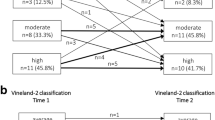Abstract
A treatment plan focusing on the social and interpersonal life of autistic children is described. It was devised and implemented based upon the idea that there is a continuum between autistic children and normal children. The observations that autistic children have decreased tendencies to approach and increased tendencies to withdraw in social situations but that they do have some capacity for interpersonal approach and that all of the observable behavior patterns seen in autistic children occur to some extent in normal children were implemented in the development of this treatment approach. A new level of therapeutic contact, the “corrective autistic experience”, is hypothesized. The treatment of ten autistic children over a five-year period is summarized.
Similar content being viewed by others
References
Alpert A, Reversibility of pathological fixations associated with maternal deprivation in infancy.Psychoanal. Study Child, 14: 169–185, 1959.
Anderson RB, Kramer DA and Stull EC: The playroom and one-way mirror in family-oriented child psychotherapy.Annual Meeting of the American Association of Psychiatric Services for Children in New Orleans, 1980.
Bender L: Childhood schizophrenia.Nerv. Child, 1: 138–140, 1942.
—: Childhood schizophrenia.Amer. J. Orthopsychiatry, 17: 40–56, 1947.
Benjamin LS: Structural analysis of social behavior.Psychol. Rev., 81: 392–425, 1974.
—: Structural analysis of a family in therapy.J. Consult. Clin. Psychol. 45: 391–406, 1977.
—: Structural analysis of differentiation failure.Psychiatry, 42: 1–23, 1979.
Bowlby J:Attachment and Loss: Vol 1, Attachment. New York: Basic Books, 1969.
Brubakken DM, Derouin JA and Morrison HL:Treatment of Psychotic and Neurologically Impaired Children: A Systems Approach. New York: Van Nostrand Reinhold, 1980.
Cohen IL, Campbell M, Posner D, Small AM, Triebel D and Anderson LT: Behavioral effects of haloperidol in young autistic children.J. Child Psychiatry, 19: 665–677, 1980.
Day M and Semard EV: Schizophrenic reactions. In Nicholi AM, Jr (ed.);The Harvard Guide to Modern Psychiatry. Cambridge: Belknap Press, pp. 199–241, 1978.
Hailman JP:Optical Signals. Bloomington: Indiana University Press, pp. 46–48, 1977.
Hutt SJ: An ethological analysis of autistic behavior. In van Praag HM (ed.);On the Origin of Schizoprenic Psychoses. Amsterdam: De Erven Bohn BV, pp. 138–172, 1975.
Koff RH: The Therapeutic Man Friday.J. Am. Psychoanal. Assoc. 5: 424–431, 1957.
Kohut H: The psychoanalytic treatment of narcissistic personality disorders: outline of a systematic approach.Psychoanal. Study Child 23: 86–113, 1968.
Kramer DA and McKinney WT Jr: The overlapping territories of psychiatry and ethology.J. Nerv. Ment. Dis. 167: 3–22, 1979.
Mahler MS: On child psychosis and schizophrenia: autistic and symbiotic infantile psychoses.Psychoanal. Study Child 7: 286–305, 1952.
—:On Human Symbiosis and the Vicissitudes of Individuation Vol 1 Infantile Psychosis. New York: International Universities Press, pp 168–169, 1968.
Massie HN: The early natural history of childhood psychosis.J. Child Psychiatry.17: 29–48, 1978.
Novak MA and Harlow HF: Social recovery of monkeys isolated for the first year of life: 1. Rehabilitation and therapy.Dev Psychol 11: 453–465, 1975.
Richer J: The social-avoidance behavior of autistic children.Anim. Behav. 24: 898–906, 1976.
Ritvo ER, Freeman BJ, Geller E and Yuwiler A: Effects of fenfluramine on 14 outpatients with the syndrome of autism.J. Child Psychiatry.22: 549–558, 1983.
Searles HF: Autism and the phase of transition to therapeutic symbiosis.Contemp. Psychoanal.7: 1–20, 1979. Reprinted in Searles HF:Countertransference. New York: International Universities Press, pp. 149–171, 1979.
—: Pathologic symbiosis and autism, In Landis B (ed.);In the Name of Life-Symposium in Honor of Erich Fromm. New York: Holt, Rinehart & Winston, pp. 69–83, 1971. Reprinted in Searles HF:Countertransference. New York: International Universities Press, pp. 132–148, 1979.
Shapiro T: Language behavior as a prognostic indicator in schizophrenic children under 42 months, In Rexford EN, Sander LW and Shapiro T (eds)Infant Psychiatry: A New Synthesis. New Haven: Yale University Press, pp. 227–238, 1976.
—: A psychiatrist for infants? In Rexford EN, Sander LW and Shapiro T (eds);Infant Psychiatry: A New Synthesis. New Haven: Yale University Press, pp. 3–6, 1976.
Spitz RA: Relevancy of direct infant observation.Psychoanal. Study Child, 5, 66–73, 1950.
Suomi SJ, Harlow HF and McKinney WT Jr: Monkey psychiatrists.Am. J. Psychiatry 128: 41–46, 1972.
Tinbergen EA and Tinbergen N: The aetiology of childhood autism: a criticism of the Tinbergen's theory: a rejoinder.Psychol. Med. 6: 545–549, 1976.
—: Early childhood autism—an ethological approach, In Tinbergen N:The Animal in its World, Vol. II, Laboratory Experiments and General Papers. Cambridge: Harvard University Press, pp. 175–199, 1972.
—: Early infantile autism—an ethological approach.Z. Tierpsychol. Suppl. 10: 1–53, 1972.
Tinbergen N: Comparative studies of the behaviour of gulls (Laridae): a progress report.Behaviour 15: 1–70, 1959.
—: The evolution of behavior in gulls.Sci. Am. 6: 18–130, 1960.
Tinbergen N: Ethology. In Harré R (ed),Scientific Thought. Oxford: Clarendon Press, pp. 238–268. Reprinted in Tinbergen N;The Animal in its World, Vol II, Laboratory Experiments and General Papers. Cambridge: Harvard University Press, pp. 130–160, 1969.
—: Ethology and stress diseases.Science 185: 20–27, 1974.
— and Falkus H:Signals for Survival. Documentary film. New York McGraw-Hill, 1970.
Whitaker CA and Malone TP:The Roots of Psychotherapy. New York: Blakiston, 1953.
Winnicott DW: The capacity to be alone.Int. J. Psychoanal. 39: 416–420. Reprinted in Winnicott DW:The Maturational Processes and the Facilitating Environment. New York: International Universities Press, pp. 29–36, 1965.
Author information
Authors and Affiliations
Additional information
This study was supported in part by NIMH Education Grant: Child Psychiatry MH15295-02, Psychiatric Training for Pediatric House Staff MH14382-03, and General Psychiatry Training Grant MH21892.
Rights and permissions
About this article
Cite this article
Kramer, D.A., Anderson, R.B. & Westman, J.C. The corrective autistic experience: An application of the models of tinbergen and mahler. Child Psych Hum Dev 15, 104–120 (1984). https://doi.org/10.1007/BF00706167
Issue Date:
DOI: https://doi.org/10.1007/BF00706167




